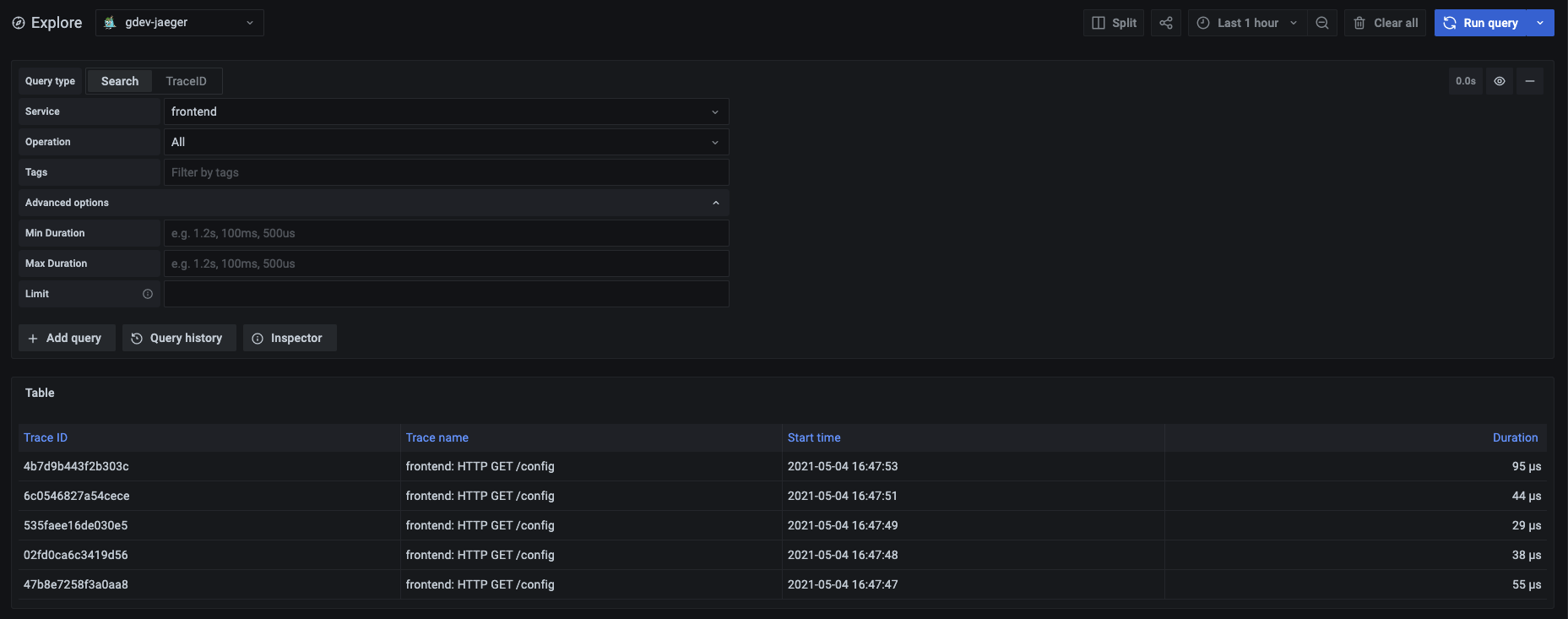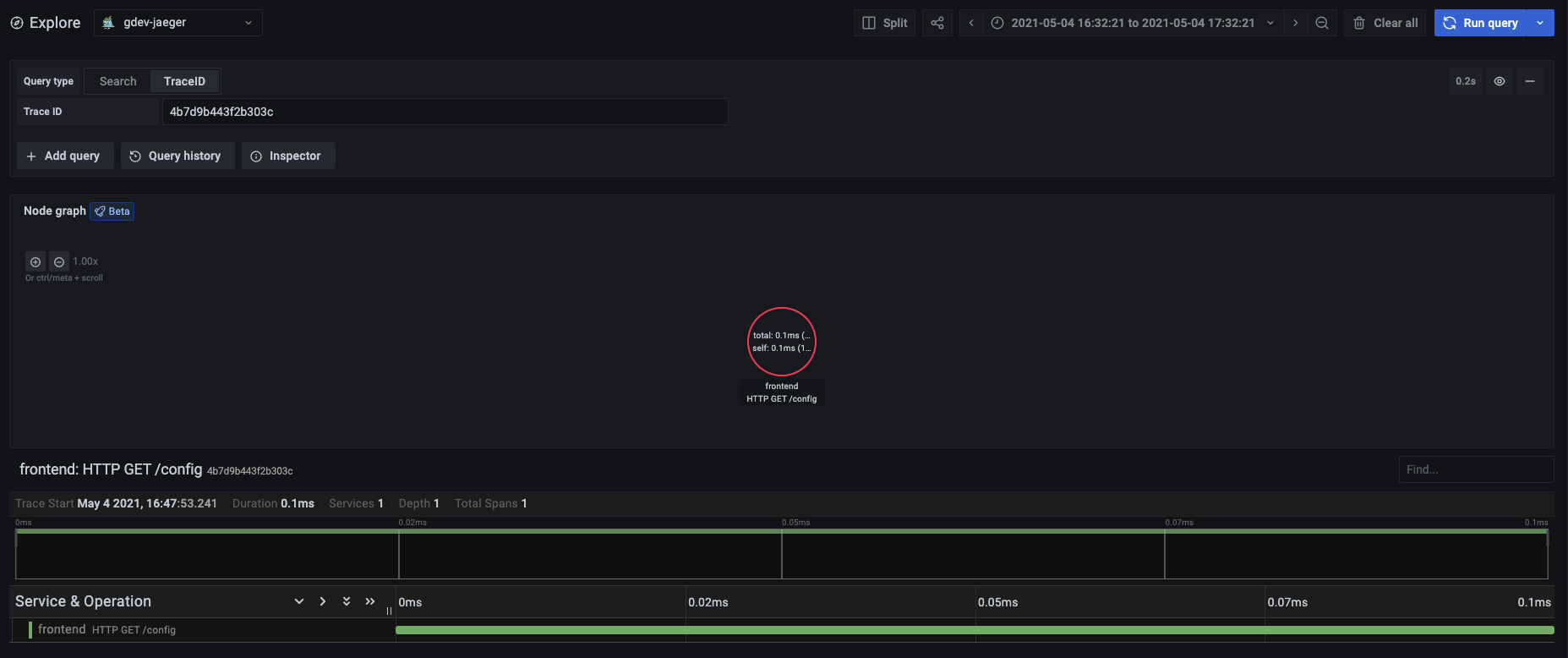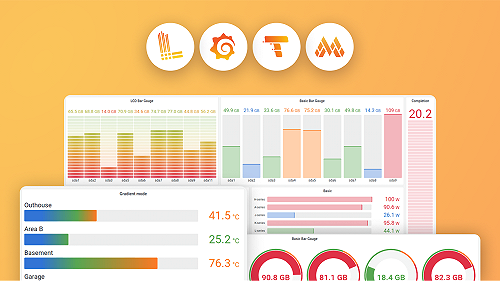Important: This documentation is about an older version. It's relevant only to the release noted, many of the features and functions have been updated or replaced. Please view the current version.
Jaeger data source
Grafana ships with built-in support for Jaeger, which provides open source, end-to-end distributed tracing. This topic explains configuration and queries specific to the Jaeger data source.
For instructions on how to add a data source to Grafana, refer to the administration documentation. Only users with the organization administrator role can add data sources. Administrators can also configure the data source via YAML with Grafana’s provisioning system.
You can also upload a JSON trace file, and link a trace ID from logs in Loki.
Configure the data source
To access the data source configuration page:
- Hover the cursor over the Configuration (gear) icon.
- Select Data Sources.
- Select the Jaeger data source.
Set the data source’s basic configuration options carefully:
You can also configure settings specific to the Jaeger data source:
Configure trace to logs
Note: Available in Grafana v7.4 and higher.
The Trace to logs section configures the trace to logs feature. Select a target data source, limited to Loki and Splunk [logs] data sources, and which tags to use in the logs query.

Configure trace to metrics
Note: This feature is behind the
traceToMetricsfeature toggle.
The Trace to metrics section configures the trace to metrics feature.
Use the settings to select the target Prometheus data source, and create any desired linked queries.
Each linked query consists of:
- Link Label: (Optional) Descriptive label for the linked query.
- Query: The query ran when navigating from a trace to the metrics data source.
Interpolate tags using the
$__tagskeyword. For example, when you configure the queryrequests_total{$__tags}with the tagsk8s.pod=podandcluster, the result looks likerequests_total{pod="nginx-554b9", cluster="us-east-1"}.
Enable Node Graph
The Node Graph setting enables the beta Node Graph visualization, which is disabled by default.
Once enabled, Grafana displays the Node Graph after loading the trace view.
Configure the span bar label
The Span bar label section helps you display additional information in the span bar row.
You can choose one of three options:
Provision the data source
You can define and configure the data source in YAML files as part of Grafana’s provisioning system. For more information about provisioning, and for available configuration options, refer to Provisioning Grafana.
Provisioning examples
Using basic auth and the trace-to-logs field:
apiVersion: 1
datasources:
- name: Jaeger
type: jaeger
uid: jaeger-spectra
access: proxy
url: http://localhost:16686/
basicAuth: true
basicAuthUser: my_user
editable: true
isDefault: false
jsonData:
tracesToLogs:
# Field with internal link pointing to a logs data source in Grafana.
# datasourceUid value must match the datasourceUid value of the logs data source.
datasourceUid: 'loki'
tags: ['job', 'instance', 'pod', 'namespace']
mappedTags: [{ key: 'service.name', value: 'service' }]
mapTagNamesEnabled: false
spanStartTimeShift: '1h'
spanEndTimeShift: '1h'
filterByTraceID: false
filterBySpanID: false
tracesToMetrics:
datasourceUid: 'prom'
tags: [{ key: 'service.name', value: 'service' }, { key: 'job' }]
queries:
- name: 'Sample query'
query: 'sum(rate(tempo_spanmetrics_latency_bucket{$__tags}[5m]))'
secureJsonData:
basicAuthPassword: my_passwordQuery traces
You can query and display traces from Jaeger via Explore.

You can query by trace ID, or use the search form to find traces.
Query by trace ID

To query by trace ID:
- Select TraceID from the Query type selector.
- Insert the ID into the text input.
Query by search
To search for traces:
- Select Search from the Query type selector.
- Fill out the search form:
Upload a JSON trace file
You can upload a JSON file that contains a single trace and visualize it. If the file has multiple traces, Grafana visualizes its first trace.

Trace JSON example
{
"data": [
{
"traceID": "2ee9739529395e31",
"spans": [
{
"traceID": "2ee9739529395e31",
"spanID": "2ee9739529395e31",
"flags": 1,
"operationName": "CAS",
"references": [],
"startTime": 1616095319593196,
"duration": 1004,
"tags": [
{
"key": "sampler.type",
"type": "string",
"value": "const"
}
],
"logs": [],
"processID": "p1",
"warnings": null
}
],
"processes": {
"p1": {
"serviceName": "loki-all",
"tags": [
{
"key": "jaeger.version",
"type": "string",
"value": "Go-2.25.0"
}
]
}
},
"warnings": null
}
],
"total": 0,
"limit": 0,
"offset": 0,
"errors": null
}Link a trace ID from logs
You can link to a Jaeger trace from logs in Loki by configuring a derived field with an internal link.
For details, refer to Derived fields section of the Loki data source documentation.



